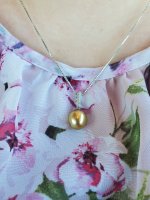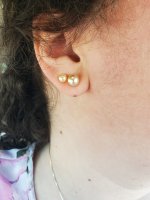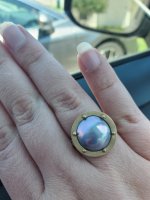jshepherd
Pearl Paradise
- Joined
- Jun 22, 2004
- Messages
- 6,344
OK so back to regulations and terminology: Can a tissue-nucleated oyster pearl be called a keshi without qualification? I guess that would be in CIBJO's current definition but I don't have the latest document to reference. When I bought the gold pearl above the natural certification fraud was ongoing, thus the seller was especially diligent about their labelling.
I don't know how one would differentiate and intentionally cultured "keshi" using tissue vs an accidental one. If intentional, it would be a non-nucleated cultured pearl.
Keshi is a Japanese term that describes small natural pearls or non-beaded cultured pearls that form as a byproduct of the culturing process. The term means poppyseed, and the name intentionally implies the pearls are very small. The term keshi has been adopted by the industry and is now used to describe similar pearls in South Sea and Tahitian.
This is from CIBJO's Blue Book -
5.106 Keshi cultured pearl
A trade term that designates a non-beaded cultured pearl (5.139) formed accidentally or intentionally by human intervention in marine pearl oysters such as the Akoya oyster (Pinctada fucata 9.54), Silver/Gold lipped oyster (9.78) (Pinctada maxima 9.60), the Black lipped oyster (Pinctada margaritifera cumingii 9.58) and Pinctada radiata; it is a by-product of the culturing process. The creation results from the formation of a cultured pearl sac either following injury of the mantle rim upon human handling, from a partial piece of the inserted (grafted) mantle tissue(5.114) or the whole inserted piece (5.163) following the rejection of a bead (5.130).See also South-sea Keshi cultured pearl (5.187), Tahitian Keshi cultured pearl(5.196) and Akoya Keshi cultured pearl (5.7). Alternative name; Lagniappe (or Bonus) cultured pearl.
5.187 South-sea keshi cultured pearl
A trade term for a keshi cultured pearl grown in Pinctada maxima (9.60). A Southsea (5.187) keshi cultured pearl (5.105) or a South-sea non-beaded cultured pearlformed accidentally in Pinctada maxima, it is a by-product of the culturing process.The creation results from the formation of a cultured pearl sac (5.54) either followinginjury of the mantle rim upon handling, or from a partial piece of the inserted(transplanted) mantle tissue (5.114), or the whole inserted piece (5.163) followingthe rejection of a bead (5.18). Some are hollow or contain relatively large amountsof organic matter.
5.196 Tahitian keshi cultured pearl
A trade term for a keshi cultured pearl grown in Pinctada margaritifera cumingii in French Polynesia. The Tahiti keshi cultured pearl (see also 5.105) or Tahiti non-beaded cultured pearl (5.139), is formed accidentally in this pearl oyster in French Polynesia and is a by-product of the culturing process. The creation results from the formation of a cultured pearl sac (5.54) either following injury of the mantle rim upon handling, from a partial piece of the inserted (transplanted) mantle tissue(5.114) or the whole inserted piece (5.163) following the rejection of a bead (5.18).Some Tahiti keshi cultured pearls are hollow or contain relatively large amounts oforganic matter.



